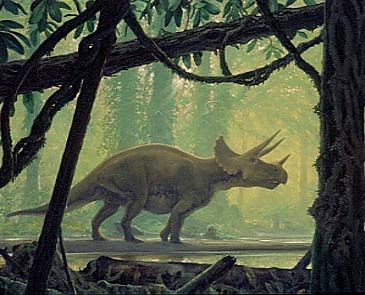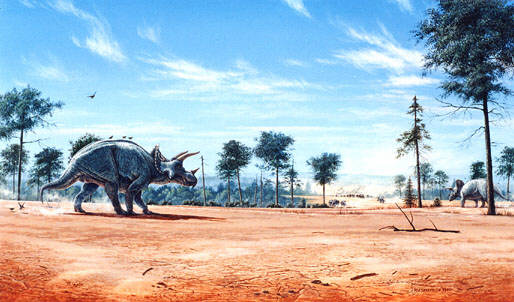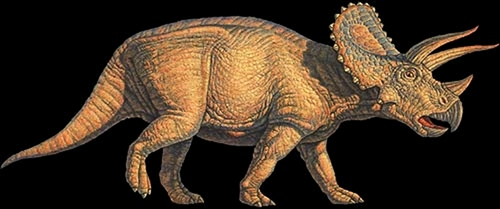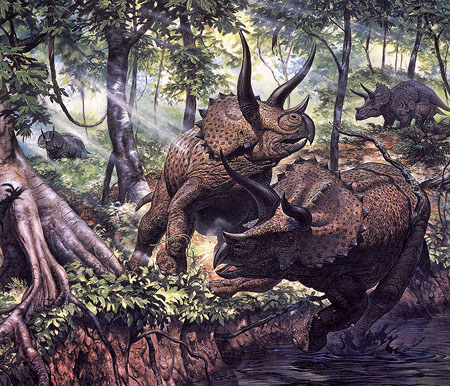Triceratops horridus - North American Dinosaurs
Homepage > North American Dinosaurs - Triceratops horridus
(Try-SAIR-uh-tops) - "three horned face"
Describer Marsh, 1889
Also Known As --
Type of Species horridus
Order Ornisthischia
SubOrder Marginocephalia
InfraOrder Ceratopsia
Micro-Order --
Family Ceratopsidae
Size 26 feet (7.9 meters) in length
Period Late Cretaceous, 70 million years ago
Fossilsite Lance Formation, Evanston Formation, Wyoming, Hell Creek Formation,
Montana, South Dakota, Laramie Formation, Colorado, US; Scollard Formation,
Alberta, Frenchman Formation, Saskatchewan, Canada
Diet Quadrupedal Herbivore
Triceratops was a rhinoceros-like dinosaur. It walked on four sturdy legs and had three horns on its face along with a large bony plate projecting from the back of its skull (a frill). One short horn above its parrot-like beak and two longer horns (over 3 feet or 1 m long) above its eyes probably provided protection from predators. The horns were possibly used in mating rivalry and rituals. It had a large skull, up to 10 feet (3 m) long, one of the largest skulls of any land animal ever discovered. Its head was nearly one-third as long as its body. Triceratops hatched from eggs.
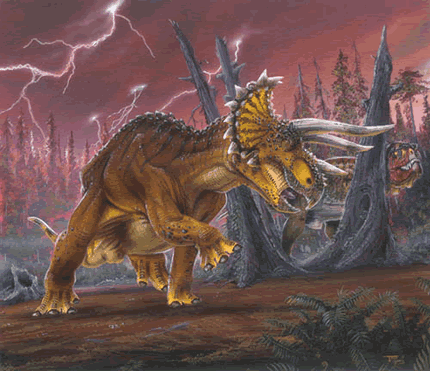
Triceratops lived in the late Cretaceous period, about 72 to 65 million
years ago, toward the end of the Mesozoic, the Age of Reptiles. It was
among the last of the dinosaur species to evolve before the Cretaceous-Tertiary
extinction 65 million years ago. Among the contemporaries of Triceratops
were Tyrannosaurus rex, Ankylosaurus, Corythosaurus, and Dryptosaurus.
Triceratops was a quadrupedal dinosaur, it was a relatively slow dinosaur.
Dinosaur speeds are estimated using their morphology and fossilized trackways.
Triceratops was an herbivore. It probably ate cycads and other low-lying
plants with its tough beak. Triceratops could chew well with its cheek
teeth. Triceratops was hunted and eaten by Tyrannosaurus rex. Coprolite
(fossilized feces) from a Tyrannosaurus rex was recently found in Saskatchewan,
Canada by a team led by Karen Chin. This 65 million year old specimen
contains chunks of bones from an herbivore (plant-eating) dinosaur which
was eaten by the Tyrannosaurus rex. This bone fragment is perhaps part
of the head frill of a Triceratops.
Species
Triceratops albertensis
Triceratops alticornis
Triceratops brevicornus
Triceratops calicornis
Triceratops elatus
Triceratops eurycephalus
Triceratops flabellatus
Triceratops galeus
Triceratops hatcheri
Triceratops horridus
Triceratops ingens
Triceratops maximus
Triceratops obtusus
Triceratops prorsus
Triceratops serratus
Triceratops sulcatus
Discovery
The first named specimen now attributed to Triceratops, was found near
Denver, Colorado in the spring of 1887. The specimen consisted of a pair
of brow horns attached to a skull roof. This specimen was sent to Othniel
Charles Marsh, at first the specimen was mistakenly identified as an unusual
bison, which he named Bison alticornis. Later, Paleontologist Othniel
Marsh named his specimen found 2 years earlier, Triceratops in 1889. Triceratops
remains have subsequently been found in the American states of Montana
and South Dakota in addition to Colorado and Wyoming, and in the Canadian
provinces of Saskatchewan and Alberta.
Triceratops horridus Paleo Gallery
Click on images to see more art from artist!
